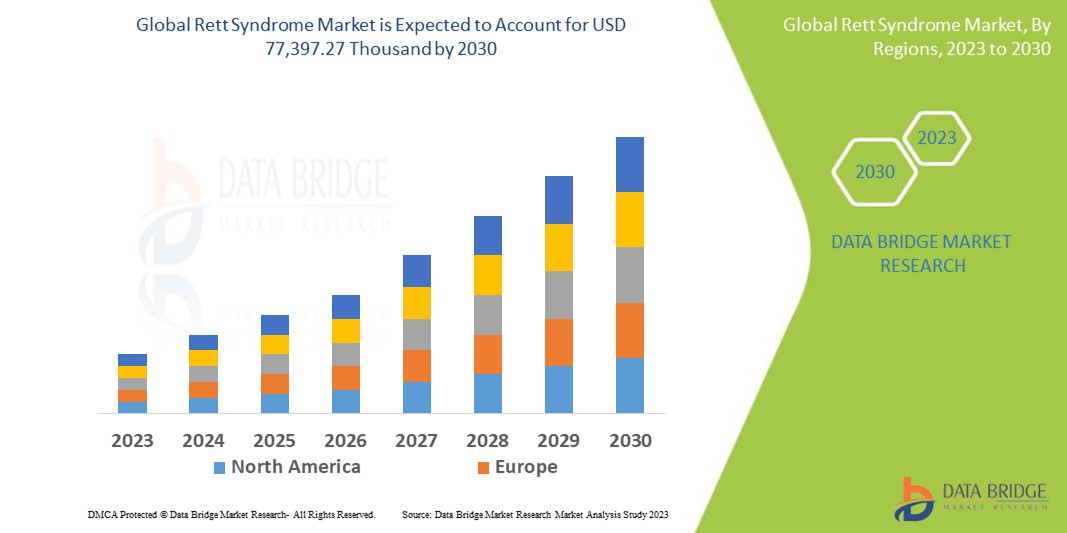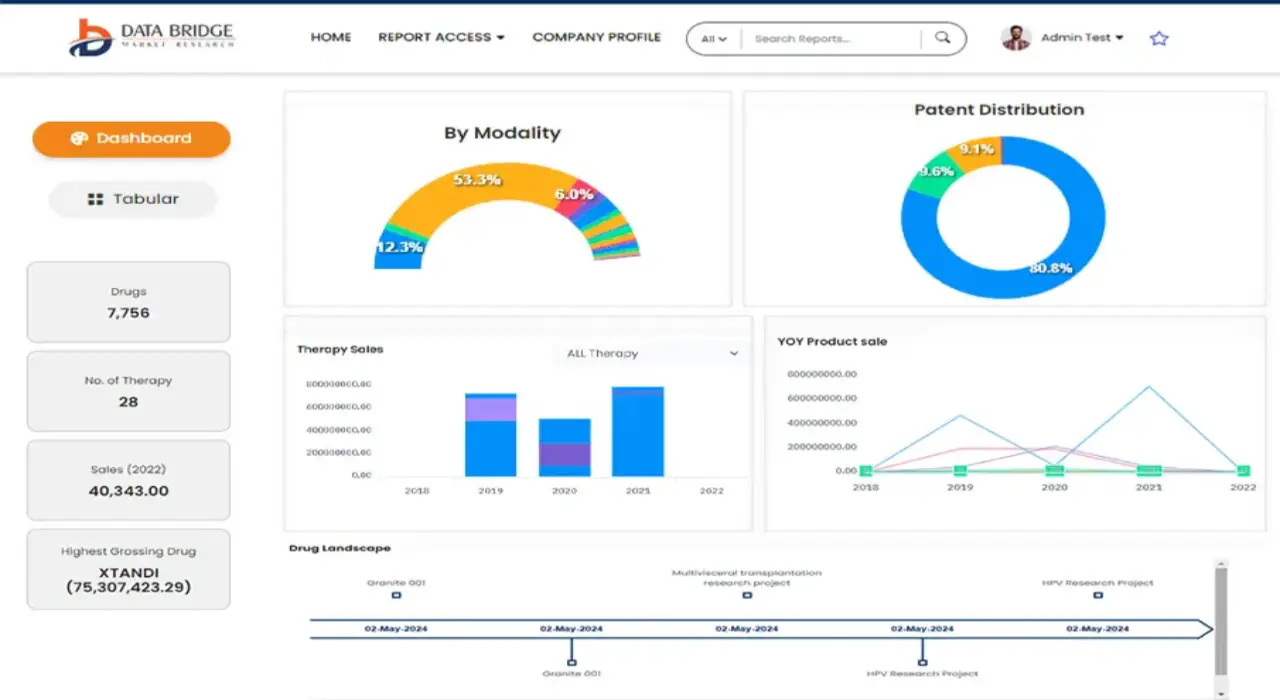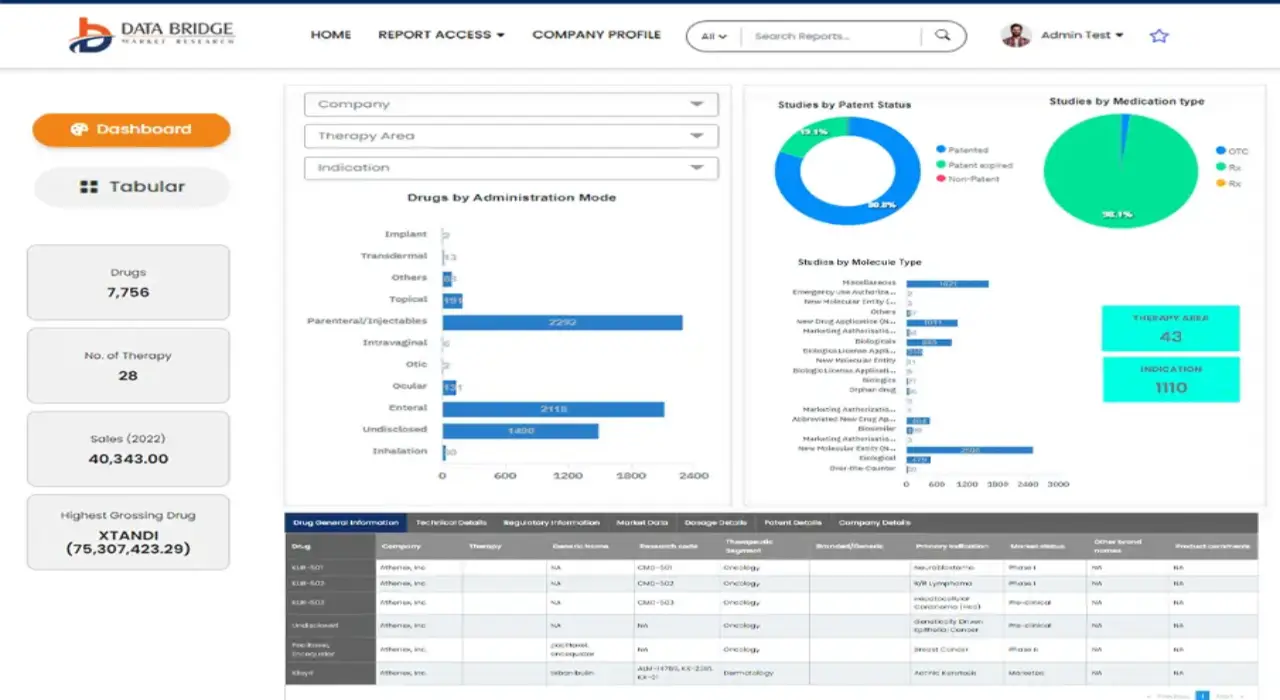Global Rett Syndrome Treatment Market
Market Size in USD Billion
CAGR :
% 
 USD
35.34 Billion
USD
3,130.02 Billion
2024
2032
USD
35.34 Billion
USD
3,130.02 Billion
2024
2032
| 2025 –2032 | |
| USD 35.34 Billion | |
| USD 3,130.02 Billion | |
|
|
|
|
Global Rett Syndrome Market, By Types (Classic Rett Syndrome, Atypical Rett Syndrome), Stages (Stage IV Late Motor Deterioration, Stage III Plateau, Stage II Rapid Destruction, Stage I Early Onset), Drug Type (Branded, Generics), Treatment Type (Drug Class, Therapy Type, and Others), End-Users (Hospitals, Specialty Clinics, Homecare, Others), Distribution Channel (Hospital Pharmacy, Retail Pharmacy, Online Pharmacy, Others), Route of Administration (Oral, Parenteral, and Others) – Industry Trends and Forecast to 2032
Rett Syndrome Market Analysis
Rett syndrome is an uncommon neurological condition that affects mostly girls. Developmental difficulties, loss of motor abilities, and speech are all symptoms of the condition. Furthermore, the syndrome is diagnosed in children aged 6 to 18 months and is caused by mutations in the MECP2 gene on the X-chromosome. Rett syndrome can cause various problems, ranging from moderate to severe. Unusual eye movements, delayed growth, agitation and anger, poor language abilities, hand movement problems, muscular and coordination challenges, and breathing problems are all common symptoms of Rett syndrome.
Rett Syndrome Market Size
The global Rett syndrome market size was valued at USD 35.34 billion in 2024 and is projected to reach USD 3,130.02 billion by 2032, with a CAGR of 75.15% during the forecast period of 2025 to 2032. In addition to the insights on market scenarios such as market value, growth rate, segmentation, geographical coverage, and major players, the market reports curated by the Data Bridge Market Research also include depth expert analysis, patient epidemiology, pipeline analysis, pricing analysis, and regulatory framework.
Report Scope and Rett Syndrome Market Segmentation
|
Attributes |
Rett Syndrome Key Market Insights |
|
Segments Covered |
|
|
Countries Covered |
U.S., Canada and Mexico in North America, Germany, France, U.K., Netherlands, Switzerland, Belgium, Russia, Italy, Spain, Turkey, Rest of Europe in Europe, China, Japan, India, South Korea, Singapore, Malaysia, Australia, Thailand, Indonesia, Philippines, Rest of Asia-Pacific (APAC) in the Asia-Pacific (APAC), Saudi Arabia, U.A.E, South Africa, Egypt, Israel, Rest of Middle East and Africa (MEA) as a part of Middle East and Africa (MEA), Brazil, Argentina and Rest of South America as part of South America |
|
Key Market Players |
Merck KGaA (Germany), Eisai Co., Ltd. (Japan), AstraZeneca (U.K.), Sanofi (France), Novartis AG (Switzerland), Abbott (U.S.), F. Hoffmann-La Roche Ltd. (Switzerland), Teva Pharmaceutical Industries Ltd. (Ireland), Pfizer Inc. (U.S.), GlaxoSmithKline plc (U.K.), WOCKHARDT (Mumbai), Novo Nordisk A/S (Denmark), Glenmark Pharmaceuticals Limited (India), Cipla Inc. (U.S.), Bausch Health Companies Inc. (Canada), Otsuka America Pharmaceutical, Inc. (U.S.), Johnson & Johnson Private Limited (U.S.), Takeda Pharmaceutical Company Limited (Japan), Sumitomo Corporation (Japan), Biocon (India) |
|
Market Opportunities |
|
|
Value Added Data Infosets |
In addition to the insights on market scenarios such as market value, growth rate, segmentation, geographical coverage, and major players, the market reports curated by the Data Bridge Market Research also include depth expert analysis, patient epidemiology, pipeline analysis, pricing analysis, and regulatory framework. |
Rett Syndrome Market Definition
Rett syndrome is rare neurological condition that primarily affects women. It is caused by a random gene mutation. Almost all patients require caregiver assistance throughout their lives. Many children with Rett syndrome reach adulthood with a high quality of life. Because there is no cure for Rett syndrome, treatment focuses on symptom management. The majority of afflicted children will benefit from occupational, physical, and speech treatment. Seizures, anxiety, sleep disorders, breathing problems, stereotypic hand movements, and certain gastrointestinal abnormalities are all signs of Rett syndrome that can be treated with drugs. Drugs can also help with muscular stiffness and spasticity.
Rett Syndrome Market Dynamics
Drivers
- Increasing Prevalence of Rett Syndrome
The increasing prevalence of Rett syndrome will fuel industry growth. The mutation in the MECP2 gene causes Rett syndrome. On the long arm of chromosome X, the MECP2 gene encodes the methyl- CpG binding protein 2. Symptoms appear as people grow older. Infants with Rett syndrome grow normally for the first six months before showing symptoms of the disease. The frequent alterations usually appear between the ages of 12 and 18 months.
- Increasing Investment for Healthcare Infrastructure
Another significant factor influencing the growth rate of global Rett syndrome market is the rising healthcare expenditure which helps in improving its infrastructure. Also, various government organizations aim to improve the healthcare infrastructure by increasing funding and this will further influence the market dynamics.
Opportunity
- New Product Launches
The surging number of product launches is estimated to create new opportunities for the growth rate of global Rett syndrome market. For instance, the US Food and Medication Administration designated AMO-04, a glutamate modulator for the treatment of Rett syndrome, as an orphan drug in June 2018. This recognition is a significant step forward in the development of this syndrome, highlighting the urgent need for a new therapeutic option for Rett syndrome.
Furthermore, the rising collaboration, merger, and acquisition among the market players will extend profitable opportunities for the market players in the forecast period of 2025-2032. Additionally, rising number of market players will further expand the market's growth rate in the future.
Restraints/Challenges
- Complications Involved with Rett Syndrome
Complications associated with this disease is anticipated to hinder the market's growth rate. Some Rett syndrome symptoms can raise a child's chance of developing health problems. Aspiration pneumonia, for instance, can be caused by swallowing or breathing problems. When food, saliva, or other liquids enter the lungs instead of the stomach, this type of pneumonia develops. Scoliosis patients are more likely to suffer lung difficulties. Uncontrolled seizures can also put you at risk for health problems.
On the other hand, the high cost associated with the product manufacturing is expected to obstruct market growth. Also, the disruption in the supply chain industry has the potential to challenge the market’s growth. Also, lack of favorable reimbursement scenario and technology penetration in the developing economies, and lack of suitable infrastructure are projected to challenge the market in the forecast period of 2025-2032.
This market report provides details of new recent developments, trade regulations, import-export analysis, production analysis, value chain optimization, market share, impact of domestic and localized market players, analyses opportunities in terms of emerging revenue pockets, changes in market regulations, strategic market growth analysis, market size, category market growths, application niches and dominance, product approvals, product launches, geographic expansions, technological innovations in the market. To gain more info on the market contact Data Bridge Market Research for an Analyst Brief, our team will help you take an informed market decision to achieve market growth.
Rett Syndrome Market Scope
The market is segmented on the basis of types, stages, treatment type, drug type, route of administration, end user, and distribution channel. The growth amongst these segments will help you analyse meagre growth segments in the industries and provide the users with a valuable market overview and market insights to help them make strategic decisions for identifying core market applications.
Types
- Classic Rett Syndrome
- Atypical Rett Syndrome
Stages
- Stage IV Late Motor Deterioration
- Stage III Plateau
- Stage II Rapid Destruction
- Stage I Early Onset
Drug Type
- Branded
- Generics
Treatment Type
- Drug Class
- Therapy Type
- Others
End-Users
- Hospitals
- Specialty Clinics
- Homecare
- Others
Distribution Channel
- Hospital Pharmacy
- Retail Pharmacy
- Online Pharmacy
- Others
Route of Administration
- Oral
- Parenteral
- Others
Rett Syndrome Market Regional Analysis
The market is analysed and market size insights and trends are provided by country, types, stages, treatment type, drug type, route of administration, end user, and distribution channel as referenced above.
The countries covered in the global Rett syndrome market report are U.S., Canada and Mexico in North America, Germany, France, U.K., Netherlands, Switzerland, Belgium, Russia, Italy, Spain, Turkey, Rest of Europe in Europe, China, Japan, India, South Korea, Singapore, Malaysia, Australia, Thailand, Indonesia, Philippines, Rest of Asia-Pacific (APAC) in the Asia-Pacific (APAC), Saudi Arabia, U.A.E, South Africa, Egypt, Israel, Rest of Middle East and Africa (MEA) as a part of Middle East and Africa (MEA), Brazil, Argentina and Rest of South America as part of South America.
North America dominates the global Rett syndrome market in terms of market share and market revenue and will continue to flourish its dominance during the forecast period 2025-2032. This is due to the presence of FDA approved wound debridement devices and rising healthcare expenditure will further propel the market's growth rate in this region. Additionally, favorable health remuneration policies, rise in chronic wounds, and a growing elderly population will further propel the market's growth rate in this region.
Asia-Pacific is expected to be the fastest-growing region during the forecast period of 2025-2032 due to increase in the number of insurance payers in this region. Also, the development of private healthcare sector and rising awareness among the people will further propel the market's growth rate in this region.
The country section of the report also provides individual market impacting factors and changes in regulation in the market domestically that impacts the current and future trends of the market. Data points such as down-stream and upstream value chain analysis, technical trends and porter's five forces analysis, case studies are some of the pointers used to forecast the market scenario for individual countries. Also, the presence and availability of global brands and their challenges faced due to large or scarce competition from local and domestic brands, impact of domestic tariffs and trade routes are considered while providing forecast analysis of the country data.
Rett Syndrome Market Share
The market competitive landscape provides details by competitor. Details included are company overview, company financials, revenue generated, market potential, investment in research and development, new market initiatives, global presence, production sites and facilities, production capacities, company strengths and weaknesses, product launch, product width and breadth, application dominance. The above data points provided are only related to the companies' focus related to market.
Rett Syndrome Market Leaders Operating in the Market Are:
- Merck KGaA (Germany)
- Eisai Co., Ltd. (Japan)
- AstraZeneca (U.K.)
- Sanofi (France)
- Novartis AG (Switzerland)
- Abbott (U.S.)
- F. Hoffmann-La Roche Ltd. (Switzerland)
- Teva Pharmaceutical Industries Ltd. (Ireland)
- Pfizer Inc. (U.S.)
- GlaxoSmithKline plc (U.K.)
- WOCKHARDT (Mumbai)
- Novo Nordisk A/S (Denmark)
- Glenmark Pharmaceuticals Limited (India)
- Cipla Inc. (U.S.)
- Bausch Health Companies Inc. (Canada)
- Otsuka America Pharmaceutical, Inc. (U.S.)
- Johnson & Johnson Private Limited (U.S.)
- Takeda Pharmaceutical Company Limited (Japan)
- Sumitomo Corporation (Japan)
- Biocon (India)
Latest Developemnt in the Rett Syndrome Market
- In December 2021, Acadia Pharmaceuticals Inc. announced the positive top-line results from the pivotal, Phase 3 Lavender study evaluating the efficacy and safety of trofinetide in 187 girls and young women aged 5-20 years suffering from Rett syndrome. Trofinetide is an experimental medication. It's a new synthetic analogue of IGF-1's aminoterminal tripeptide that could help with Rett syndrome's fundamental symptoms by lowering neuroinflammation and supporting synaptic function. Trofinetide is expected to promote synaptic maturation and help patients overcome the synaptic and neuronal immaturities that are common in Rett syndrome
SKU-
Get online access to the report on the World's First Market Intelligence Cloud
- Interactive Data Analysis Dashboard
- Company Analysis Dashboard for high growth potential opportunities
- Research Analyst Access for customization & queries
- Competitor Analysis with Interactive dashboard
- Latest News, Updates & Trend analysis
- Harness the Power of Benchmark Analysis for Comprehensive Competitor Tracking
Research Methodology
Data collection and base year analysis are done using data collection modules with large sample sizes. The stage includes obtaining market information or related data through various sources and strategies. It includes examining and planning all the data acquired from the past in advance. It likewise envelops the examination of information inconsistencies seen across different information sources. The market data is analysed and estimated using market statistical and coherent models. Also, market share analysis and key trend analysis are the major success factors in the market report. To know more, please request an analyst call or drop down your inquiry.
The key research methodology used by DBMR research team is data triangulation which involves data mining, analysis of the impact of data variables on the market and primary (industry expert) validation. Data models include Vendor Positioning Grid, Market Time Line Analysis, Market Overview and Guide, Company Positioning Grid, Patent Analysis, Pricing Analysis, Company Market Share Analysis, Standards of Measurement, Global versus Regional and Vendor Share Analysis. To know more about the research methodology, drop in an inquiry to speak to our industry experts.
Customization Available
Data Bridge Market Research is a leader in advanced formative research. We take pride in servicing our existing and new customers with data and analysis that match and suits their goal. The report can be customized to include price trend analysis of target brands understanding the market for additional countries (ask for the list of countries), clinical trial results data, literature review, refurbished market and product base analysis. Market analysis of target competitors can be analyzed from technology-based analysis to market portfolio strategies. We can add as many competitors that you require data about in the format and data style you are looking for. Our team of analysts can also provide you data in crude raw excel files pivot tables (Fact book) or can assist you in creating presentations from the data sets available in the report.













